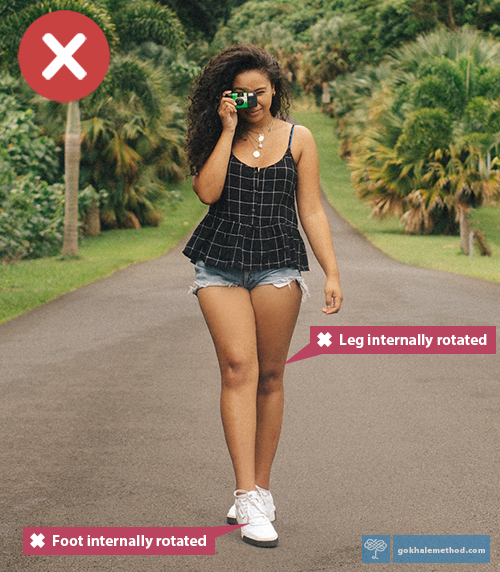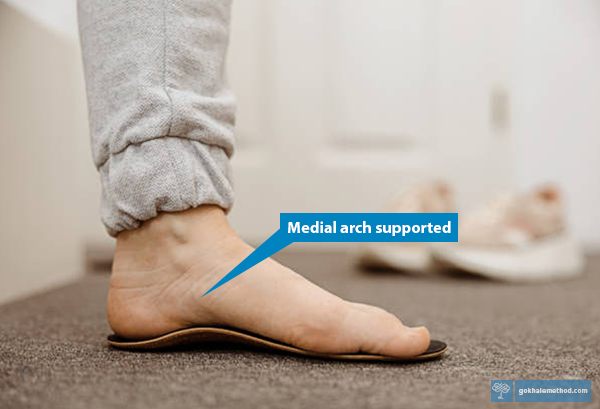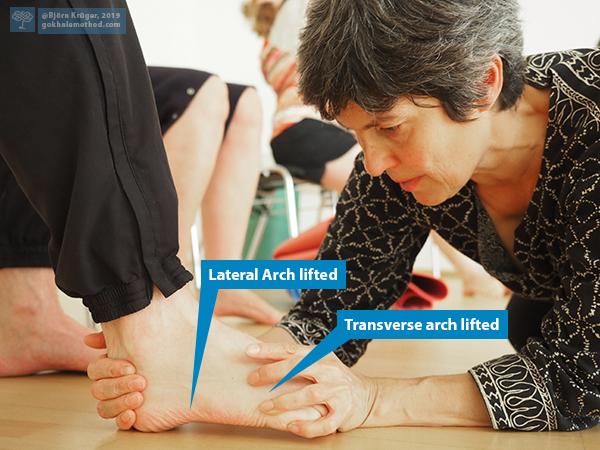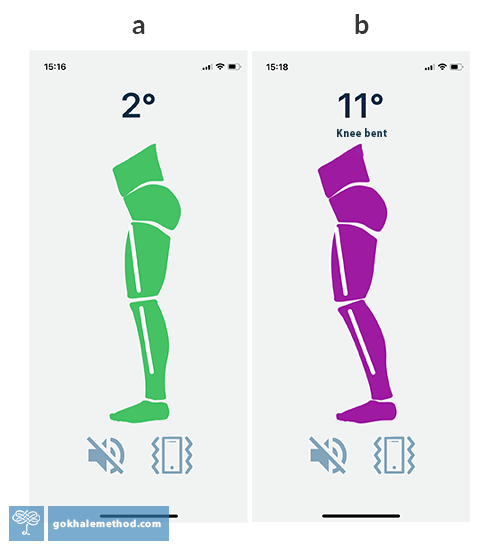Fixing Plantar Fasciitis
Why is it not a routine practice for podiatrists to observe their plantar fasciitis patients’ stance and gait? Let’s consider how a broader approach that considers the way people stand and walk could improve treatment outcomes for plantar fasciitis patients—and also help prevent recurrences.
The main factors in foot health
In my experience, the top three influences on the health and performance of the human foot are the architecture and orientation of the foot and leg, the way a person stands, and the way a person walks. Of course, shoes also play a big role in foot health (you can read more about this here), but while truly healthy posture can do a lot to compensate for poor shoes (extreme styles excepted), the best of shoes cannot make up for poor posture, stance, and gait.

These African fishermen all show healthy external rotation in their legs and feet. Pexels

Internal leg rotation mechanically disadvantages our structure, and offers poor support to the feet and legs. Pexels
What gives rise to foot problems
We frequently work with people whose foot problems have been created or made worse by poor postural habits. While there can be a genetic predisposition to foot problems, frequently, what appears to be a genetic trait is actually the result of mimicking those closest to us—the person with bunions has replicated their parent’s poor posture or poor shoe choices which, in turn, caused their bunions.
Let’s consider what can go wrong in the feet when standing. In a common modern stance where the hips are parked forward relative to the feet, the body’s weight lands excessively on the smaller, more delicate structures of the midfoot and forefoot. The ligaments that bind the bones in the feet together may no longer be able to do their job in preserving the shape and healthy function of the foot.

How you stand affects your weight bearing and the forces going through your feet. This man has parked his pelvis forward, shifting his weight off his heels and onto the more delicate forefoot. Pexels
Plantar fasciitis
Plantar fasciitis is one common problem that results from faulty weight distribution overwhelming the foot ligaments. Other problems may include calcium deposits (bone spurs) at points of stress, nerve damage such as in Morton’s neuroma, inflammation such as in sesamoiditis, and stress fractures.
Plantar fasciitis affects the strong, fibrous attachment that runs from your heel bone to the ball of your foot, supporting the medial and lateral arches. The ligament-like tissue becomes irritated and inflamed, making it painful to bear weight or use the foot, especially on initial standing.

Plantar fasciitis occurs when the connective tissue on the sole of the foot becomes inflamed. Pexels
Treatment of conditions such as plantar fasciitis is often limited to local solutions. A common treatment for plantar fasciitis is to stretch the plantar fascia with exercise, manual therapy or by wearing night splints. This has some protective merit as it reduces the degree of tearing that can occur under the body's weight. Another measure that can offer relief is foot rolling with iced water bottles.
After observing the shape of the patient’s foot, a podiatrist might prescribe an orthotic. The most conservative treatment with orthotics simply reflects the shape of the foot and aims to prevent further deterioration of the foot’s structure. Somewhat more sophisticated orthotics are designed to exert corrective forces on the foot, such as lifting a sunken arch.
A root-cause solution is to learn how to stand and walk well. Instead of band-aid stretching and orthotics to compensate for weak muscles and poor body mechanics, this approach will lead to a strengthening of the foot muscles, an overall shortening of the foot, and appropriate weight-bearing on the foot at all times. When students come to us with orthotics, we encourage them to think of the orthotic as a training device that reminds the foot to practice what it needs to do, as well as being a prop for as long as they need it to do some of the lifting for them.

Once the foot muscles have learned to grip around the contours of an arch support the foot can go beyond resting passively as shown here.
Learning to activate the feet is especially beneficial for anyone with “flat” feet. It’s also important for women during pregnancy, since both the additional weight of a baby and the hormone relaxin increase any tendency to ligament laxity.
Key components of Gokhale Method® training in our in-person Foundations course, one-day Pop-up course, and our online Elements course will enable you to make profound and lasting changes for your feet. You can learn how to:
- Place much of your body weight on your heels. These are large, dense bones with a cross-fiber construction that are well suited to load-bearing compared with the comparatively delicate forefoot with its longer, thinner bone structure.
- Kidney-bean shape your foot, keeping its structural integrity.
- Use your foot muscles to interact with the ground, providing stability and propulsion.
- Coordinate your foot action with the external rotation of the leg and activation of the glutes.
- Antevert your pelvis, stack your spine, and align your upper body as part of healthy standing and glidewalking.

We pay a lot of attention to the feet in all our courses. Here I am showing a student how to kidney-bean shape their foot.
Is hi-tech the answer to foot problems?
Computer technology has enabled podiatrists to measure foot shape, weight bearing, and biomechanics with a precision that was previously unattainable. There have been exciting advances in clinical 3D scanning and modeling, and the use of sensors to measure real time movement and weight distribution. There is also an increased biomechanical understanding of how gait interacts with foot function.
However, the medical model of foot and gait health continues to arrive at conclusions based on abstract reasoning instead of tried and true historical and anthropological evidence. It therefore continues to encourage modern distortions like a “straight” foot and “straight ahead” feet. We would love to see a shift in the medical perception of healthy feet and gait that weaves in ancestral wisdom.
The Gokhale Method has developed two wearables that help refine students’ stance and gait. The five-sensor SpineTracker™ wearable is used by many of our teachers in a classroom setting to allow them and their students to monitor and track real-time changes in spinal shape during gait. The two-sensor PostureTracker™ is a consumer product that enables students to refine their stance and gait at home, work, or leisure.

The PostureTracker setting Piston Walking can tell you if you are successfully straightening your back leg while walking (a) or not (b); this is relevant to the healthy function of your feet.
Free Online Workshop: “Fix Your Feet”
On Wednesday, May 24, 1pm PT, we will be offering a Free Online Workshop, Fix Your Feet. If you would like to volunteer for a mini-consultation in this workshop, please email teamesther@gokhalemethod with a brief description of your foot condition. If you would like to support friends and family who suffer from foot problems, please feel free to email them.
Best next action steps for newcomers
If you would like insight on your foot issues and posture, consider scheduling an Initial Consultation, online, or in person.
You can sign up below to join one of our upcoming FREE Online Workshops. . .

Comments
Thank you for such a great
Thank you for such a great article on foot and gait health, and how important it is. I am 64; maintain a healthy weight (another culprit to foot issues is carrying too much weight); and have been especially mindful of my posture over the past 8+ years (thanks in part to Esther!), yet I have struggled off and on the majority of my life with bunions. Nothing severe, but troublesome just the same. And I was diagnosed a few months ago with a Neuroma on my right foot, after dealing with some intermittent pain. I always wear quality low or no-heel shoes and try to do everything else right; yet I still suffer from these foot issues. However lately I have been massaging Frankincense essential oil around the neuroma area and it has felt much better ... wanted to pass that along.
Add New Comment
Login to add commment
Login